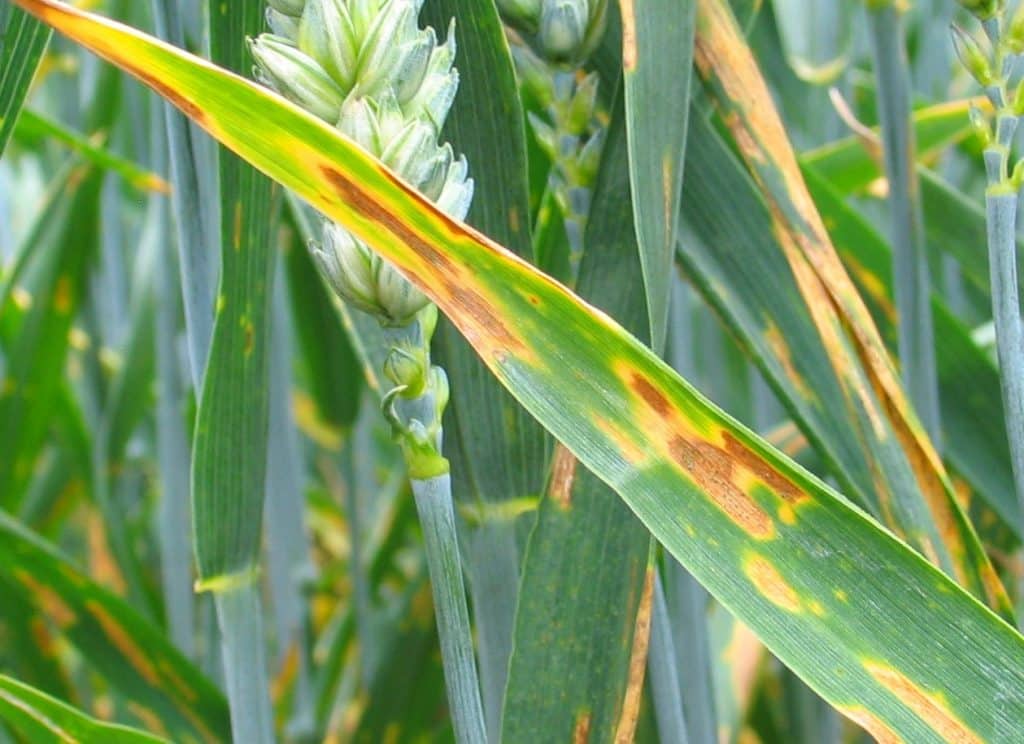High disease risk requires a robust T2
Warm and wet conditions throughout April and into May have ramped up the Septoria and rust pressure in many wheat crops ahead of the crucial flag leaf (T2) fungicide timing,...
“For many parts of the country we have already received the same amount of rainfall we usually expect throughout April and the whole of May in a ‘normal’ disease year,” says the firm’s head of integrated crop management, David Howard.
“Any further rainfall throughout the rest of May will push us into a more abnormal high Septoria situation, as we saw in 2012. The South West is already close to this and reports of significant Septoria pressure are common. Remember, that due to its latent period, just assessing visible Septoria on the leaves can be misleading.”
Mr Howard says that in many crops, especially susceptible varieties, Septoria infection is present to varying degrees on lower leaves (four and five onwards), with some growers reporting symptoms on leaf three, which will greatly increase the risk of spores splashing onto upper leaves.
Both brown and yellow rust have also been more prevalent in crops, and in the case of brown rust, it has come in much earlier than normal, he adds.
“Brown rust is a significant feature of this season. Although it began in varieties with a brown rust weakness, such as Crusoe (rated 3), it is now becoming prevalent in a number of other varieties and should be accounted for in any T2 application.
“These established rust situations have been challenging to fully eradicate, and with high humidity and increasing temperatures we can expect very rapid cycling of brown rust.”
Protect the flag leaf
Leaves one and two contribute up to 70% of total yield potential, so Mr Howard says it is essential to protect them as much as possible with a robust T2 (growth stage 39) fungicide that covers all of the main disease threats.
Product choice and dose should be tailored to the disease spectrum and risk, but accurate timing is key, he continues.
“Applications should be made once the flag leaves on the main tiller are 75% to fully emerged (GS 39), even if the T1 or T1.5 has only relatively recently been applied.”
Hitting this optimum timing could be more challenging though given the ongoing unsettled weather, rapid growth, and wide variations in crop maturity, by region and drilling date.
“Crops range anywhere from leaf three still emerging to flag leaf partially out, and are likely to move rapidly through the final growth stages as temperatures increase. The weather forecast to the end of May looks increasingly stormy and wet, which will add to already high April rainfall figures in some areas.”
In previous years, there has been more flexibility on the flag leaf spray timing, with applications delayed to catch ears and upper leaves at the same time. But given the current high disease pressure, such an approach is not recommended, Mr Howard says.
T2 options
For high Septoria pressure situations, or crops with the greatest yield potential, Mr Howard says the strongest option currently on the market is pydiflumetofen plus prothioconazole. This will also bring some early control of fusarium inoculum, but should be used with a rust-active azole where curative rust control is also required, or a strobilurin in more protectant rust situations.
Other effective Septoria options include products based on isoflucypram, fenpicoxamid, or mefentrifluconazole plus fluxapyroxad. Mr Howard reminds growers that both isoflucypram and fenpicoxamid products are limited to just one application per year, and there are specific water rates that must be used for fenpicoxamid, which may impact on application speed.
Where disease risk is lower, such as in later-drilled crops, or where T1 control was effective, bixafen+ fluopyram mixtures will be useful, but rates need to be increased to reflect disease pressure, he notes.
All options will benefit from the addition of a multi-site product as part of an anti-resistance strategy and to maintain Septoria protection up to ear emergence. In the case of folpet, it will bring some extra rust activity too, he adds.
For specific rust control, Mr Howard says tebuconazole or metconazole are the main triazoles, while benzovindiflupyr is the strongest SDHI on yellow rust. Another good yellow rust option would be isoflucypram-based mixtures, particularly where they have a rust-active partner also having good activity on brown rust. Mefentrifluconazole products are generally more active on brown rust than yellow, but under higher pressure are likely to require more curative support, he adds.
“The addition of strobilurins, such as fluoxastrobin, azoxystrobin or pyraclostrobin, will add extra persistence on rusts and a lesser degree of knockdown.”
